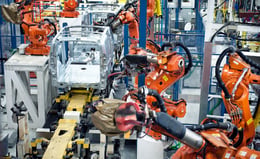The Key Components of Industry 4.0
Kristin Masters - December 15, 2016

With the introduction of Industry 4.0, the German government issued a call to action to the global manufacturing industry, one that pushes the industry to evolve beyond conventional boundaries of technology, communication and capacity. So how does the modern supply chain move in the right direction? By focusing on these key capabilities, supply chain leaders can foster strategic evolution toward the more agile supply chain of Industry 4.0.
Greater Customization Through Additive Manufacturing
Commonly known as 3D printing, additive manufacturing is the process of building an object by depositing material in multiple layers. The use of additive manufacturing has certainly become trendy, but it has yet to reach its full potential. Industry 4.0 provides the technological infrastructure for manufacturing enterprises to use 3D technology at scale, producing smaller numbers of more customized products. And because additive technology can be done on demand, production time for those customized products is also significantly shorter. One hallmark of a true Industry 4.0 enterprise, therefore, is the robust integration of additive manufacturing throughout the supply chain, not only to produce products for end users, but also for the manufacture of customized machine parts within the supply chain itself.
Full Integration of Advanced Analytics
Virtually all supply chain leaders currently rely on analytics to inform and optimize production. Indeed, the implementation of analytics consistently yields higher production quality, along with reduced downtime and improved customer experience — all contributing to a better bottom line. But these analytics are often disjointed or orphaned, existing without cohesive connection to an overarching system. As the manufacturing world continues to evolve toward Industry 4.0, analytics systems are simultaneously evolving. The Industry 4.0 supply chain uses advanced analytics and Big Data to inform end-to-end (E2E) visibility. Up-to-the-minute data are available to support real-time decision-making and bring visibility to the entire supply chain, both within and without individual organizations.
A Move Beyond Postmodern ERP
The Postmodern ERP mindset has just begun to catch hold in the supply chain industry, yet Industry 4.0 pushes the boundaries of even this cutting-edge approach. Industry 4.0 calls for a truly agile supply chain that integrates IT systems both vertically and horizontally. Using robust data-integration networks that span usually-disconnected departments like engineering and customer services, the Industry 4.0 company is much more cohesive. And because these data systems can communicate beyond the boundaries of the company, they provide unprecedented integration, resulting in a much more agile supply chain.
Widespread Incorporation of the Internet of Things
Another aspect of that integration is the incorporation of networked machines and sensors throughout the supply chain. The Internet of Things (IoT) refers to computing technology embedded in devices, which can communicate with other devices and people through the internet. Currently IoT is most often found vertically within an organization; for instance, the supply chain's devices and sensors communicate with each other, providing useful but limited intelligence to the manufacturing control system. The next phase, however, incorporates the IoT to communicate across departments as well. Much like IT system software will be integrated, so too will devices, sensors and humans throughout the organization. The Industry 4.0 supply chain fully leverages the IoT for streamlined, agile operations with far greater visibility and transparency.
Increased Reliance Upon the Cloud
The Industry 4.0 supply chain is a data-generation machine. It's constantly producing insights in real time, requiring incredible speed and precision, not to mention the capacity for instant access and E2E visibility. Those demands are best met in the Cloud. As Cloud technology continues to improve, the Industry 4.0 enterprise will increasingly deploy it for data management and functionality. Coupled with seemingly endless storage capacity and an ever-shortening reaction time, the Cloud offers the necessary agility for the supply chain of the next generation.
Autonomous (and Cooperative) Robots
Just as additive manufacturing is in its infancy, so is the use of autonomous robots. That's largely because the technology is expensive, and the capacities of autonomous robots are still rather limited. But as the capacities and costs of autonomous robots continue to improve, this technology will play an increasingly important role in the Industry 4.0 supply chain. Experts predict that in the very near future, autonomous robots will interact with each other and humans, When enabled with machine learning, these robots will truly revolutionize the supply chain, making the whole system more agile, integrated and proactive. The Industry 4.0 supply chain fully incorporates and capitalizes on autonomous robotics.
Enhanced Cybersecurity
The increased dependence on interconnected devices and data leaves the supply chain incredibly vulnerable. The first step for supply chain leaders is to establish robust communication and connectivity protocols that can be easily adopted across the enterprise. These protocols are a strong line of defense, but they must be complemented and supported by rigorous identity access management that protect all manufacturing lines and critical industrial systems. Thus the Industry 4.0 enterprise must constantly make cybersecurity a top priority.
If you want to learn more get your Guide to Industry 4.0:
LATEST POSTS
- Understand Why Production Planning Needs Specialized Solutions
- Understand Circular Economy in The Manufacturing Industry
- How Can Industry 4.0 IT Integration Be Achieved Smoothly?
- The Significance of Order Sequencing in Discrete Manufacturing
- How to improve your Supply Chain Management: The Power of Control Towers



